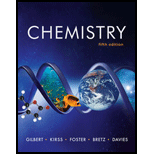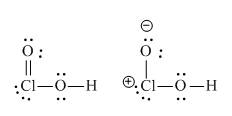
Concept explainers
Interpretation: The Lewis structure of the given oxyacids of chlorine using the formal charge and the possible resonance structure is to be identified.
Concept introduction: The Lewis symbols of the atoms indicate the total number of valence electrons surrounding the atom or the ions.
Formal charge is calculated by the formula,
To determine: The Lewis structure of all the resonance forms of
Answer to Problem 8.142AP
Solution
There are two resonating structures of
Explanation of Solution
Explanation
The
Therefore, the electronic configuration of oxygen is
Thus, the number of valence electrons of oxygen is
The atomic number of chlorine is
Therefore, the electronic configuration of chlorine is
Thus, the number of valence electrons of chlorine is
The atomic number of hydrogen is
Therefore, the electronic configuration of hydrogen is
Thus, the number of valence electrons of hydrogen is
Thus, the total number of valence electrons of
Therefore, the possible Lewis structures of

Figure 1
Formal charge is calculated by the formula,
Therefore, the formal charge of chlorine on the right Lewis structure containing four nonbonding electrons and four bonding electrons is,
The formal charge of oxygen on the right Lewis structure containing six nonbonding electrons and two bonding electrons is,
The formal charge of chlorine on the left Lewis structure containing six nonbonding electrons and two bonding electrons is,
The formal charge of oxygen on the left Lewis structure containing four nonbonding electrons and four bonding electrons is,
Therefore, the left Lewis structure is correct.
The total number of valence electrons of
Therefore, the possible Lewis structures of

Figure 2
The formal charge of chlorine on the right Lewis structure containing four nonbonding electrons and four bonding electrons is,
The formal charge of oxygen on the right Lewis structure containing six nonbonding electrons and two bonding electrons is,
The formal charge of chlorine on the left Lewis structure containing four nonbonding electrons and six bonding electrons is,
The formal charge of oxygen on the left Lewis structure containing four nonbonding electrons and four bonding electrons is,
The left Lewis structure is correct and the two structures are the resonating structures of each other.
The total number of valence electrons of
Therefore, the possible Lewis structures of

Figure 3
The formal charge of chlorine on the Lewis structure containing two nonbonding electrons and eight bonding electrons is,
The formal charge of chlorine on the Lewis structure containing two nonbonding electrons and six bonding electrons is,
The formal charge of oxygen on the Lewis structure containing six nonbonding electrons and two bonding electrons is,
The formal charge of chlorine on the Lewis structure containing two nonbonding electrons and ten bonding electrons is,
The formal charge of oxygen on the left Lewis structure containing four nonbonding electrons and four bonding electrons is,
Therefore, the extreme right Lewis structure is correct and the three structures are the resonating structures of each other.
Conclusion:
There are two resonating structures of
Want to see more full solutions like this?
Chapter 8 Solutions
Smartwork5 Printed Access Card for Use with Chemistry: The Science in Context 5th Edition (SmartWork Access Printed Access Card)
- 5. Write the formation reaction of the following complex compounds from the following reactants: 6. AgNO₃ + K₂CrO₂ + NH₄OH → 7. HgNO₃ + excess KI → 8. Al(NO₃)₃ + excess NaOH →arrow_forwardIndicate whether the product formed in the reaction exhibits tautomerism. If so, draw the structure of the tautomers. CO₂C2H5 + CH3-NH-NH,arrow_forwardDraw the major product of this reaction N-(cyclohex-1-en-1-yl)-1-(pyrrolidino) reacts with CH2=CHCHO, heat, H3O+arrow_forward
- Draw the starting material that would be needed to make this product through an intramolecular Dieckmann reactionarrow_forwardDraw the major product of this reaction. Nitropropane reacts + pent-3-en-2-one reacts with NaOCH2CH3, CH3CHOHarrow_forwardIndicate whether the product formed in the reaction exhibits tautomerism. If so, draw the structure of the tautomers. OC2H5 + CoHs-NH-NH,arrow_forward
- Explain how substitutions at the 5-position of barbituric acid increase the compound's lipophilicity.arrow_forwardExplain how substitutions at the 5-position of phenobarbital increase the compound's lipophilicity.arrow_forwardName an interesting derivative of barbituric acid, describing its structure.arrow_forward
- Briefly describe the synthesis mechanism of barbituric acid from the condensation of urea with a β-diketone.arrow_forwardGiven the hydrazones indicated, draw the structures of the enamines that can be formed. Indicate the most stable enamine (explain). C6H5 C6H5 H C6H5 Harrow_forward4. Propose a Synthesis for the molecule below. You may use any starting materials containing 6 carbons or less (reagents that aren't incorporated into the final molecule such as PhзP do not count towards this total, and the starting material can have whatever non-carbon functional groups you want), and any of the reactions you have learned so far in organic chemistry I, II, and III. Your final answer should show each step separately, with intermediates and conditions clearly drawn.arrow_forward
 ChemistryChemistryISBN:9781305957404Author:Steven S. Zumdahl, Susan A. Zumdahl, Donald J. DeCostePublisher:Cengage Learning
ChemistryChemistryISBN:9781305957404Author:Steven S. Zumdahl, Susan A. Zumdahl, Donald J. DeCostePublisher:Cengage Learning ChemistryChemistryISBN:9781259911156Author:Raymond Chang Dr., Jason Overby ProfessorPublisher:McGraw-Hill Education
ChemistryChemistryISBN:9781259911156Author:Raymond Chang Dr., Jason Overby ProfessorPublisher:McGraw-Hill Education Principles of Instrumental AnalysisChemistryISBN:9781305577213Author:Douglas A. Skoog, F. James Holler, Stanley R. CrouchPublisher:Cengage Learning
Principles of Instrumental AnalysisChemistryISBN:9781305577213Author:Douglas A. Skoog, F. James Holler, Stanley R. CrouchPublisher:Cengage Learning Organic ChemistryChemistryISBN:9780078021558Author:Janice Gorzynski Smith Dr.Publisher:McGraw-Hill Education
Organic ChemistryChemistryISBN:9780078021558Author:Janice Gorzynski Smith Dr.Publisher:McGraw-Hill Education Chemistry: Principles and ReactionsChemistryISBN:9781305079373Author:William L. Masterton, Cecile N. HurleyPublisher:Cengage Learning
Chemistry: Principles and ReactionsChemistryISBN:9781305079373Author:William L. Masterton, Cecile N. HurleyPublisher:Cengage Learning Elementary Principles of Chemical Processes, Bind...ChemistryISBN:9781118431221Author:Richard M. Felder, Ronald W. Rousseau, Lisa G. BullardPublisher:WILEY
Elementary Principles of Chemical Processes, Bind...ChemistryISBN:9781118431221Author:Richard M. Felder, Ronald W. Rousseau, Lisa G. BullardPublisher:WILEY





